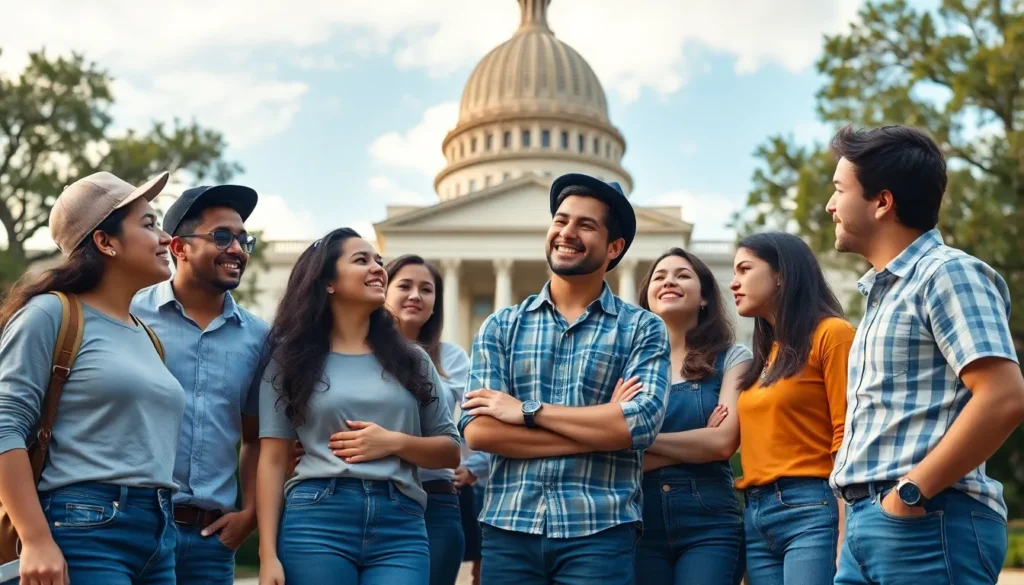Texas, the Lone Star State, has long been a political enigma wrapped in cowboy boots and barbecue sauce. Is it a red state, waving its Republican flag high, or has it dipped its toes into the blue waters of Democratic ideals? With its vast landscapes and even vaster opinions, Texas often feels like a political rollercoaster, where the only thing more unpredictable than the weather is the voting behavior of its residents.
Table of Contents
ToggleOverview of Texas Politics
Texas embodies a complex political identity, balancing a strong Republican base with emerging Democratic influences. The state’s residents demonstrate a diverse range of opinions, contributing to its political dynamism.
Historical Context
Texas holds a rich political history shaped by its unique cultural and demographic makeup. Since the 1970s, Republicans gained dominance, winning most state and federal elections. The 2010 Congressional elections marked a significant turning point, with Republicans securing 25 of 36 congressional seats. Notably, demographic shifts, including an increase in Hispanic voters, began influencing political outcomes, signaling a gradual transformation in Texas politics.
Current Political Landscape
Currently, Texas leans Republican, with the party controlling state legislature and statewide offices. Recent elections, however, show signs of competition, particularly in urban areas like Austin and Houston. Despite Republican strength, Democrats achieved notable victories in 2020, closing the gap in several key races. The changing demographics and shifting voter preferences suggest a potential evolution in voter alignment, creating a political landscape marked by both tradition and change.
Key Factors Influencing Texas Politics

Texas politics reflects the interplay of various demographic and economic factors. Changes in population dynamics and financial conditions shape voter behavior and party alignment.
Demographics
Diverse demographics play a crucial role in Texas politics. The Hispanic population, which comprises over 39% of Texans, significantly influences election outcomes. Millennials represent another important group, accounting for about 25% of eligible voters. Urban centers like Austin and Houston see higher concentrations of young, progressive voters, contributing to Democratic gains. The shift in population from rural to urban areas impacts political leanings, driving more competition in traditionally Republican strongholds. In contrast, rural areas maintain a strong Republican presence, underscoring the state’s complex political fabric.
Economic Factors
Economic conditions also shape Texas political dynamics. A robust economy, driven by sectors like energy, technology, and agriculture, attracts a diverse workforce. This economic growth has led to rising demand for social services, prompting discussions around government involvement. High job creation rates encourage migration, particularly from Democratic-leaning states, adding to the complexity of Texas’ political landscape. Rural economies often rely on agriculture, favoring conservative policies, while urban areas, facing challenges like affordability and infrastructure, lean towards progressive solutions. These economic contrasts create tension between rural and urban voters, influencing election outcomes.
Major Political Parties in Texas
Texas features a dynamic political landscape primarily shaped by the Republican and Democratic parties. Understanding the influence of both parties highlights the ongoing shifts within the state’s electorate.
Republican Party Dominance
Republicans hold significant power in Texas, having controlled the governor’s mansion since 1995. Their dominance extends to the state legislature, where they enjoy a strong majority. This control allows Republicans to implement conservative policies aligned with their base. The party’s support is notable among rural voters, who often prioritize traditional values and economic growth. Additionally, the success of Republicans mirrors a national trend, as Texas remains a pivotal state in influencing federal elections, having hosted key victories since the 2010 Congressional elections. Their stronghold remains unabated, though emerging challenges loom on the horizon.
Democratic Party Growth
Democrats show increasing strength, particularly in urban centers like Austin and Houston. Notably, shifts in demographic composition have empowered the party; the Hispanic electorate plays a critical role, contributing to a growing coalition of voters. Recent elections highlight this trend, as Democrats made significant gains in 2020, indicating a potential shift in voter preferences. Millennials also increasingly back Democratic candidates, motivated by progressive policies on social issues and economic opportunities. As the state continues to evolve, Democratic influence suggests a more competitive political arena, challenging the long-standing Republican dominance in Texas.
Recent Election Trends
Texas demonstrates a dynamic political environment with notable shifts in recent elections.
Federal Elections
In the 2020 presidential election, Joe Biden claimed 46.5% of the Texas vote, a significant increase for Democrats. This marked the closest margin in a Texas election since 1996. Prior to this, Donald Trump secured the state with 52.1% support in 2016, showcasing a gradual trend toward more competitive federal races. Congressional elections reflect similar changes, as Democrats flipped two seats in 2018, demonstrating urban voters’ growing influence. The increasing Hispanic representation among voters also plays a critical role, as its impact factors heavily in federal election outcomes. This evolving landscape suggests future elections could further challenge Texas’s Republican stronghold.
Statewide Elections
Statewide elections indicate increased Democratic competitiveness, particularly in urban regions. In the 2018 gubernatorial race, Democrat Beto O’Rourke garnered nearly 47% of the vote against incumbent Greg Abbott, emphasizing shifting voter sentiments. More than 13 million Texans cast ballots during this election cycle, revealing high engagement levels. Democratic candidates have made significant strides in the realm of statewide offices, yet Republicans maintain control, having won the last 20 statewide elections. Factors like increased turnout among younger voters and the expanding Hispanic electorate shape these races. Consequently, statewide elections in Texas show signs of evolving dynamics, with future contests likely to be closely contested.
Analysis of Key Issues
Texas’s political landscape reveals complex dynamics shaped by various key issues, particularly immigration and education.
Immigration
Immigration remains a hot-button topic in Texas politics. The state has a sizable immigrant population, which influences the electorate significantly. More than 39% of Texans identify as Hispanic, a demographic heavily impacted by immigration policies. While Republican leaders often push for stricter border control and enforcement, many Democrats advocate for comprehensive immigration reform that supports pathways to citizenship. Recent debates highlight the contrasting views on how immigration affects the economy and community integration. The rising number of undocumented immigrants has sparked discussions about labor markets, education access, and healthcare resources, making immigration a crucial factor in shaping political alliances and preferences.
Education
Education policies significantly impact Texas’s political landscape. Texas manages one of the largest public education systems in the United States, with over 5 million students enrolled. Funding disparities often create tension between urban and rural districts, with urban areas advocating for increased resources to address growing student populations. Public school performance, especially in science, math, and reading, varies widely, prompting calls for reform. Some argue for greater investment in early childhood education to improve long-term outcomes. Continued discussions regarding teacher pay, curriculum standards, and school choice further complicate political alignments, as different groups push for their educational priorities in a rapidly changing demographic environment.
Texas embodies a complex political landscape that defies simple categorization. While it remains a Republican stronghold with significant influence, emerging Democratic trends signal a shift in voter dynamics. The state’s diverse demographics and evolving urban centers are reshaping political alignments, making Texas a battleground for competing ideologies.
As the political climate continues to evolve, the interplay between tradition and change will play a crucial role in shaping future elections. With increasing voter engagement and demographic shifts, Texas is poised for a political transformation that could redefine its identity in the years to come. The ongoing competition between the two major parties will undoubtedly keep Texas in the spotlight as it navigates its unique political journey.





